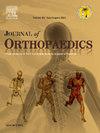人工运动学对齐全膝关节置换术中胫骨坡度匹配的准确性
IF 1.5
Q3 ORTHOPEDICS
引用次数: 0
摘要
背景:全膝关节置换术(TKA)中胫骨后坡(PTS)的重建改善了患者的预后,并最大限度地减少了包括下沉、聚乙烯磨损和不稳定在内的并发症。影像学作为一种测量PTS角度及其与手术结果的关系的方法已经被研究过。关于手动运动学对齐(KA) TKA中匹配PTS的准确性缺乏文献。方法本研究是一项回顾性研究,包括2021年10月至2024年8月由一名外科医生进行的299例原发性手动KA tka。主要结果是术前和术后PTS角度的比较。在侧位x线片上测量胫骨平台切线与垂直于胫骨轴的线之间的夹角。结果术前平均胫骨斜度为10.3°(std - dev, 4.8),术后平均胫骨斜度为5.3°(std - dev, 3.2) (p <;0.00001)。术后活动范围得到改善,平均伸直从4.4°增加到0.9°,屈曲从118.5°保持到117.2°。并发症很少,1例浅表感染,2例假体关节感染需要翻修,2例额外的聚乙烯置换手术,5例麻醉下操作,随后活动范围改善。结论在本研究中,我们发现手工KA TKA术后术前和术后胫骨斜角的x线测量有显著差异。本文章由计算机程序翻译,如有差异,请以英文原文为准。
Accuracy of matching tibial slope in manual kinematically aligned total knee arthroplasty
Background
Reproduction of the posterior tibial slope (PTS) during total knee arthroplasty (TKA) improves patient outcomes and minimizes complications including subsidence, polyethylene wear, and instability. The use of imaging has been previously studied as a way of measuring PTS angle and its association with surgical outcomes. There is a lack of literature on the accuracy of matching PTS during manual kinematically aligned (KA) TKA.
Methods
This is a retrospective study including 299 primary manual KA TKAs between October 2021 and August 2024 by a single surgeon. The primary outcome was comparison of pre-operative and post-operative PTS angles. Measurements were performed on lateral radiographs as the angle between the tangent line of the tibial plateau and a line perpendicular to the tibial shaft axis.
Results
The average pre-operative tibial slope was 10.3° (std dev, 4.8) compared to an average post-operative measurement of 5.3° (std dev, 3.2) (p < 0.00001). Range of motion improved post-operatively, with average extension increasing from 4.4° to 0.9° and flexion maintained from 118.5° to 117.2°. Complications were infrequent, with one superficial infection, two prosthetic joint infections requiring revision, two additional reoperations for polyethylene exchanges, and five manipulations under anesthesia with subsequent improvement in range of motion.
Conclusion
In this study, we found a significant difference in pre-operative and post-operative tibial slope angle on radiographic measurements following manual KA TKA.
求助全文
通过发布文献求助,成功后即可免费获取论文全文。
去求助
来源期刊

Journal of orthopaedics
ORTHOPEDICS-
CiteScore
3.50
自引率
6.70%
发文量
202
审稿时长
56 days
期刊介绍:
Journal of Orthopaedics aims to be a leading journal in orthopaedics and contribute towards the improvement of quality of orthopedic health care. The journal publishes original research work and review articles related to different aspects of orthopaedics including Arthroplasty, Arthroscopy, Sports Medicine, Trauma, Spine and Spinal deformities, Pediatric orthopaedics, limb reconstruction procedures, hand surgery, and orthopaedic oncology. It also publishes articles on continuing education, health-related information, case reports and letters to the editor. It is requested to note that the journal has an international readership and all submissions should be aimed at specifying something about the setting in which the work was conducted. Authors must also provide any specific reasons for the research and also provide an elaborate description of the results.
 求助内容:
求助内容: 应助结果提醒方式:
应助结果提醒方式:


